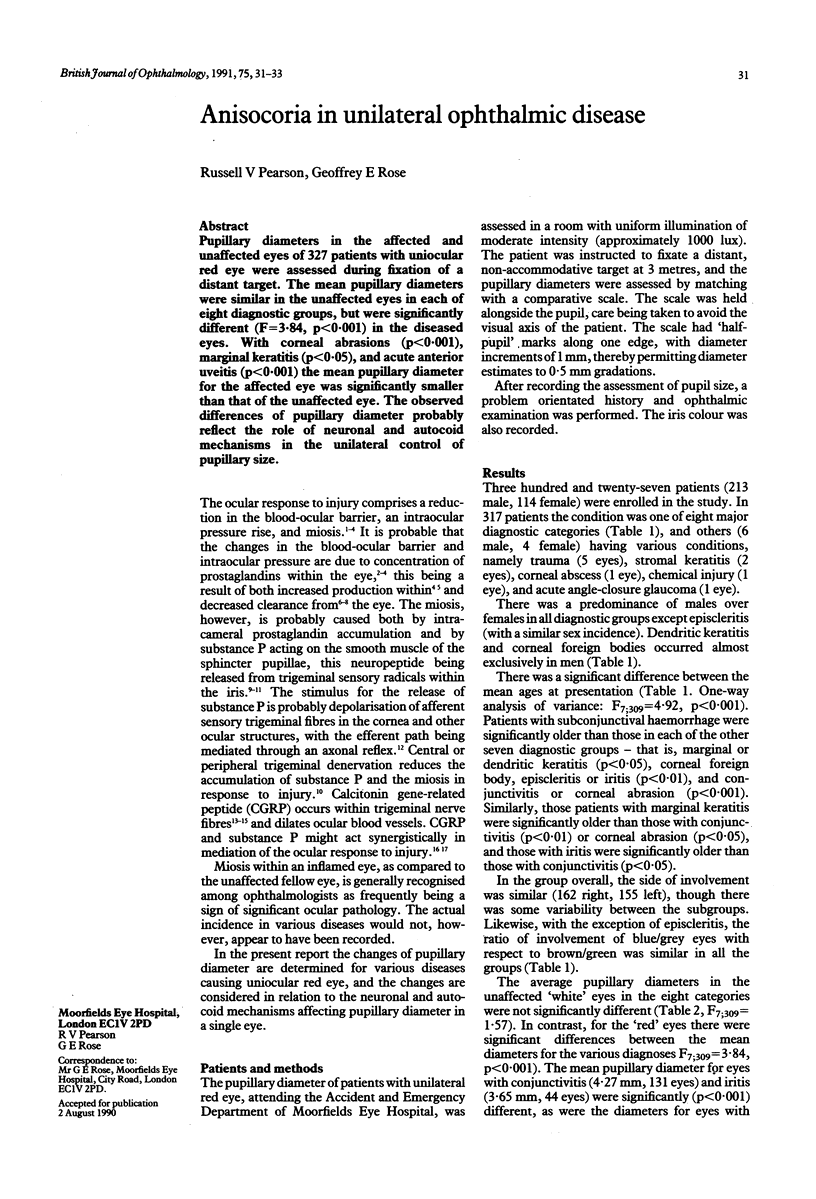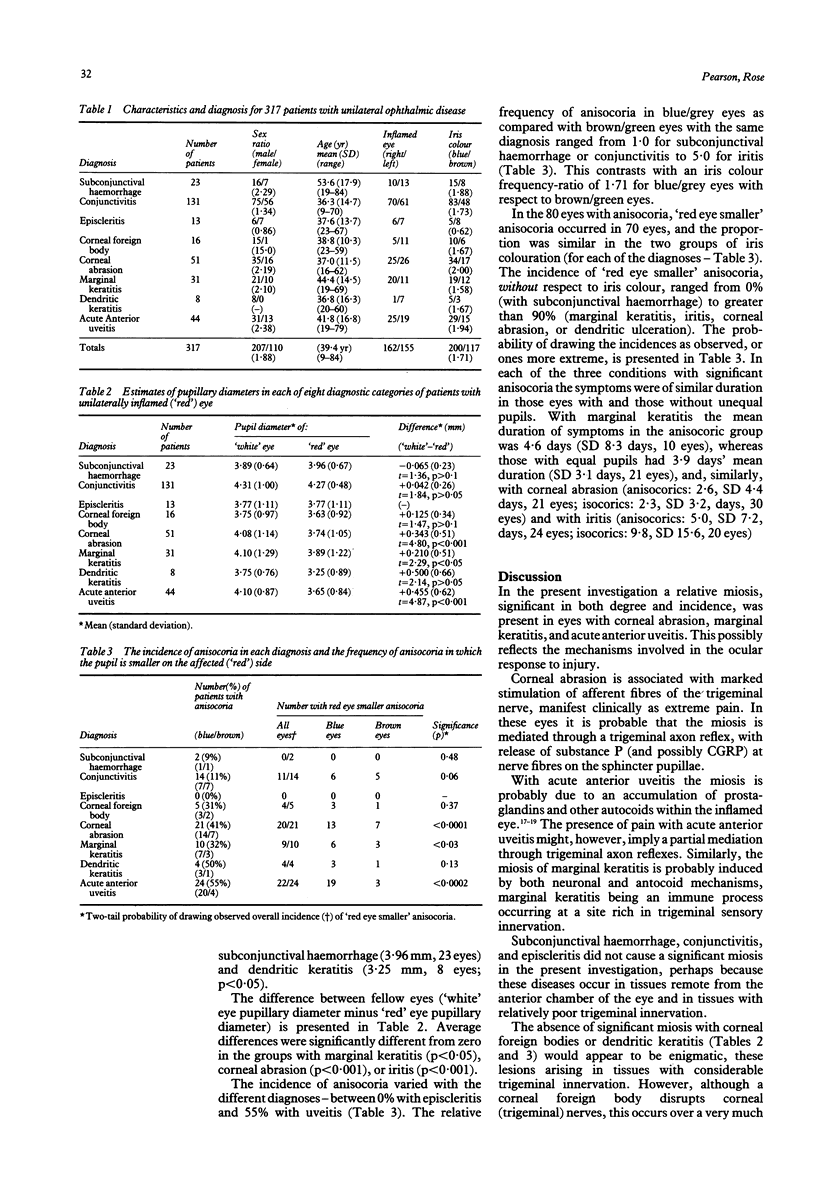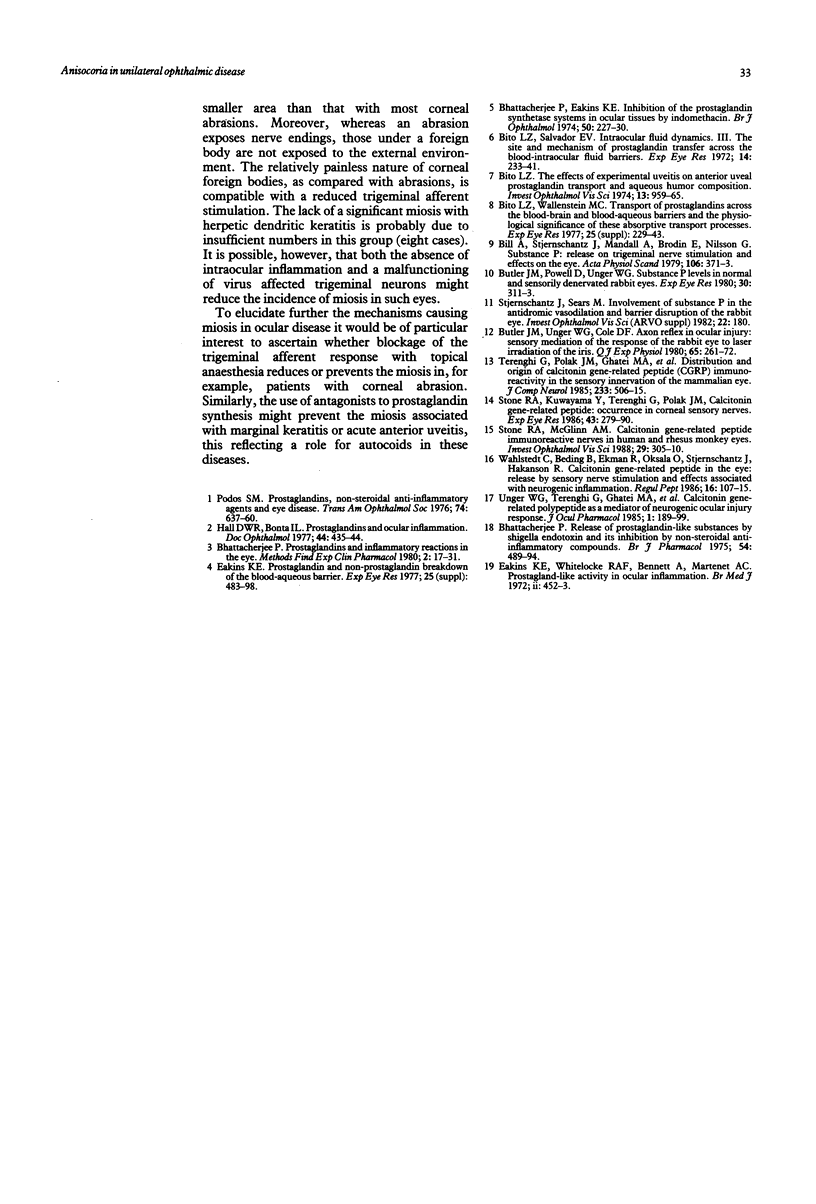Abstract
Pupillary diameters in the affected and unaffected eyes of 327 patients with uniocular red eye were assessed during fixation of a distant target. The mean pupillary diameters were similar in the unaffected eyes in each of eight diagnostic groups, but were significantly different (F = 3.84, p less than 0.001) in the diseased eyes. With corneal abrasions (p less than 0.001), marginal keratitis (p less than 0.05), and acute anterior uveitis (p less than 0.001) the mean pupillary diameter for the affected eye was significantly smaller than that of the unaffected eye. The observed differences of pupillary diameter probably reflect the role of neuronal and autocoid mechanisms in the unilateral control of pupillary size.
Full text
PDF


Selected References
These references are in PubMed. This may not be the complete list of references from this article.
- Abraham F. A., Cohen D., Sohmer H. Usher's syndrome: electrophysiological tests of the visual and auditory systems. Doc Ophthalmol. 1977 Dec 30;44(2):435–444. doi: 10.1007/BF00230092. [DOI] [PubMed] [Google Scholar]
- Bhattacherjee P., Eakins K. E. Inhibition of the prostaglandin synthetase systems in ocular tissues by indomethacin. Br J Pharmacol. 1974 Feb;50(2):227–230. doi: 10.1111/j.1476-5381.1974.tb08565.x. [DOI] [PMC free article] [PubMed] [Google Scholar]
- Bhattacherjee P. Prostaglandins and inflammatory reactions in the eye. Methods Find Exp Clin Pharmacol. 1980 Feb;2(1):17–31. [PubMed] [Google Scholar]
- Bhattacherjee P. Release of prostaglandin-like substances by Shigella endotoxin and its inhibition by non-steroidal anti-inflammatory compounds. Br J Pharmacol. 1975 Aug;54(4):489–494. doi: 10.1111/j.1476-5381.1975.tb07595.x. [DOI] [PMC free article] [PubMed] [Google Scholar]
- Bill A., Stjernschantz J., Mandahl A., Brodin E., Nilsson G. Substance P: release on trigeminal nerve stimulation, effects in the eye. Acta Physiol Scand. 1979 Jul;106(3):371–373. doi: 10.1111/j.1748-1716.1979.tb06412.x. [DOI] [PubMed] [Google Scholar]
- Bito L. Z., Salvador E. V. Intraocular fluid dynamics. 3. The site and mechanism of prostaglandin transfer across the blood intraocular fluid barriers. Exp Eye Res. 1972 Nov;14(3):233–241. doi: 10.1016/0014-4835(72)90008-5. [DOI] [PubMed] [Google Scholar]
- Bito L. Z. The effects of experimental uveitis on anterior uveal prostaglandin transport and aqueous humor composition. Invest Ophthalmol. 1974 Dec;13(12):959–966. [PubMed] [Google Scholar]
- Bito L. Z., Wallenstein M. C. Transport of prostaglandins across the blood-brain and blood-aqueous barriers and the physiological significance of these absorptive transport processes. Exp Eye Res. 1977;25 (Suppl):229–243. doi: 10.1016/s0014-4835(77)80020-1. [DOI] [PubMed] [Google Scholar]
- Butler J. M., Powell D., Unger W. G. Substance P levels in normal and sensorily denervated rabbit eyes. Exp Eye Res. 1980 Mar;30(3):311–313. doi: 10.1016/0014-4835(80)90012-3. [DOI] [PubMed] [Google Scholar]
- Butler J. M., Unger W. G., Cole D. F. Axon reflex in ocular injury: sensory mediation of the response of the rabbit eye to laser irradiation of the iris. Q J Exp Physiol Cogn Med Sci. 1980 Oct;65(4):261–272. doi: 10.1113/expphysiol.1980.sp002516. [DOI] [PubMed] [Google Scholar]
- Eakins K. E. Prostaglandin and non-prostaglandin mediated breeakdown of the blood-aqueous barrier. Exp Eye Res. 1977;25 (Suppl):483–498. doi: 10.1016/s0014-4835(77)80043-2. [DOI] [PubMed] [Google Scholar]
- Eakins K. E., Whitelocke R. A., Bennett A., Martenet A. C. Prostaglandin-like activity in ocular inflammation. Br Med J. 1972 Aug 19;3(5824):452–453. doi: 10.1136/bmj.3.5824.452. [DOI] [PMC free article] [PubMed] [Google Scholar]
- Podos S. M. Prostaglandins, nonsteroidal anti-inflammatory agents and eye disease. Trans Am Ophthalmol Soc. 1976;74:637–660. [PMC free article] [PubMed] [Google Scholar]
- Stone R. A., Kuwayama Y., Terenghi G., Polak J. M. Calcitonin gene-related peptide: occurrence in corneal sensory nerves. Exp Eye Res. 1986 Aug;43(2):279–283. doi: 10.1016/s0014-4835(86)80097-5. [DOI] [PubMed] [Google Scholar]
- Stone R. A., McGlinn A. M. Calcitonin gene-related peptide immunoreactive nerves in human and rhesus monkey eyes. Invest Ophthalmol Vis Sci. 1988 Feb;29(2):305–310. [PubMed] [Google Scholar]
- Terenghi G., Polak J. M., Ghatei M. A., Mulderry P. K., Butler J. M., Unger W. G., Bloom S. R. Distribution and origin of calcitonin gene-related peptide (CGRP) immunoreactivity in the sensory innervation of the mammalian eye. J Comp Neurol. 1985 Mar 22;233(4):506–516. doi: 10.1002/cne.902330410. [DOI] [PubMed] [Google Scholar]
- Unger W. G., Terenghi G., Ghatei M. A., Ennis K. W., Butler J. M., Zhang S. Q., Too H. P., Polak J. M., Bloom S. R. Calcitonin gene-related polypeptide as a mediator of the neurogenic ocular injury response. J Ocul Pharmacol. 1985 Summer;1(2):189–199. doi: 10.1089/jop.1985.1.189. [DOI] [PubMed] [Google Scholar]
- Wahlestedt C., Beding B., Ekman R., Oksala O., Stjernschantz J., Håkanson R. Calcitonin gene-related peptide in the eye: release by sensory nerve stimulation and effects associated with neurogenic inflammation. Regul Pept. 1986 Dec 22;16(2):107–115. doi: 10.1016/0167-0115(86)90054-6. [DOI] [PubMed] [Google Scholar]


